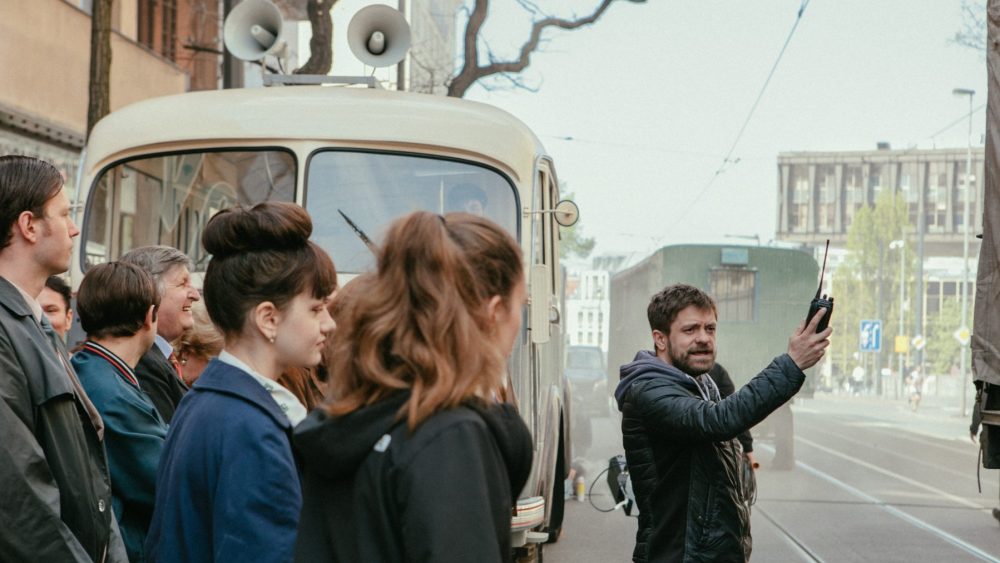When “Waves” director and writer Jiří Mádl first came across the history of Czechoslovakian radio while studying journalism in college, he discovered something that didn’t add up.
“I knew what happened in ‘68 and I knew that the radio had a very important role in those days,” Mádl said. “I knew that the [Soviet] troops came and they cut off the building … But I never saw the contradiction that the radio building was cut off. So how did the [journalists] actually manage to broadcast?”
That gap on the timeline, as Mádl puts it, was the impetus for years of research through archives, books and materials about the group of journalists from the International News Office of Czechoslovak Radio. The subject of “Waves,” Czech Republic’s official entry for the 2025 Academy Awards, is the broadcast that changed the world and the journalists who risked their lives in the process.
Vojtech Vodochodský stars as Tomás Havlík in the film “Waves.”
Courtesy of Martin Žiaran
One of the film’s most pivotal scenes tracks the Soviet tanks that invaded the country as hundreds of citizens surrounded the radio station, trying to prevent them from cutting off the broadcast. The film crew spent two months location scouting to find both the right exterior for the radio station and the best hallways, which proved difficult given how modern many of Czech Republic’s streets look today.
With the real life radio station no longer existing, “Waves” ended up using Barrandov Studios, Czech Republic’s largest film studio.
The exterior of the recreated International News Office of Czechoslovak Radio station.
Courtesy of Hana Knížová
“We built the radio station in the Barrandov Studios,” Mádl said. “This all had to be built according to the photos … Then we didn’t get permission to bring the tanks in front of the radio building so we could only bring the upper part of the tank, which is made of wood.”
The crew ended up shooting different insert shots of the tanks at different places around the country, up to two hours away from Prague, to give the illusion of continuity.
“It was very difficult but we always needed to know where we are and what we are doing,” Mádl said. “What is actually the connection point in the frame that makes it seamless? There was a lot of engineering, I would say.”
“Waves” also mixes the past and present, intersplicing archival footage from the Soviet invasion with Mádl’s dramatic reconstruction of history. The effect often makes it difficult for the viewer to discern what is archival footage and what isn’t.
For Mádl, finding the right archival footage came after already finalizing the screenplay. He worked closely with his DP, production designer and editor with each assembly.
“You can’t let yourself get too amazed by the archive,” Mádl said. “It’s not your job. You need to tell the story. First there was the shape, I call it the Christmas Tree, and then we only found the garnish to put on top of that.”
Six months before filming started, the cast and crew lost around 20% of their budget due to the rising prices during the Russo-Ukrainian War.
“We needed to cut six shooting days out of the schedule,” Mádl said. “There was a little storyline about the politician Alexander Dubček that I simply decided to ditch because it was impossible … There were some cases where I regretted that we didn’t have more money. But I feel gratitude that we actually managed to [finish the film], so I tend to forget what it actually was [we lost].”
A group of Czech journalists fight to broadcast their message during 1968 Prague Spring in “Waves.”
Courtesy of Martin Žiaran
Despite how much information Mádl was able to find through extensive research, when meeting some of the actual journalists from the story, there were some contradictions from the journalists’ perspectives. While they were often in the same room at the same time, they didn’t recall key moments the same way.
“Which was very surprising because I thought there would be a guideline, like historians say what it was, but it wasn’t true,” Mádl said. “The story of the journalists was supposed to be really hidden and buried by the Soviet Union. After the invasion, they erased all their records and they fired them from the radio. They even forced them to immigrate.”
Mádl had to trust his instincts to complete the story based on what seemed most probable — much like the leap of faith the film’s protagonist has to take to broadcast the truth.
“Waves” released overseas in the Czech Republic on Aug. 15 and does not have a U.S. release date yet.
Read the full article here


